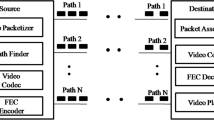Abstract
Application layer multicast (ALM) algorithms are either similar or conceptually based on network layer multicast’s cost functions. In this research work, a new application-network cross layer multi-variable cost function is proposed. It optimizes the variable requirements and available resources from both the application and the network layers. It can dynamically update the available resources required for reaching a particular node on the ALM’s media distribution tree. Mathematical derivation and theoretical analysis have been provided for the newly proposed cost function so that it can be applied in more general cases of different contexts. An evaluation platform of an overlay network built over a convergent underlay network comprised of a simulated Internet topology and a real 4G mobile WiMAX IEEE802.16e wireless network is constructed. The performance of the newly proposed cross-layer multi-variable cost function is evaluated and compared with conventional cost functions in scalable video coding-based services such as video multicast and video conferencing services using the evaluation platform. Intensive evaluation results have shown that the newly proposed cross-layer multi-variable cost function outperforms the conventional cost function and improves the performance of multimedia services on dynamic convergent network environments.













Similar content being viewed by others
References
Banerjee, S., Bhattacharjee, B., & Kommareddy, C. (2002). Scalable application layer multicast. In Proceedings of the 2002 conference on applications, technologies, architectures, and protocols for computer communications (p. 217). ACM.
Baumgart, I., Heep, B., & Krause, S. (2007). OverSim: A flexible overlay network simulation framework. In Proceedings of 10th IEEE global internet symposium (GI07) in conjunction with IEEE INFOCOM. Citeseer, 2007 (Vol. 7, pp. 79–84).
Boivie, R., Feldman, N., Imai, Y., Livens, W., Ooms, D., & Paridaens, O. (2000). Explicit multicast (Xcast) concepts and options. IEEE Network, 14(1), 78–88.
Bueno, A., Vila, P., & Fabregat, R. (2007). Multicast extension of unicast charging for QoS services. In Proceedings of 4th IEEE European conference on universal multiservice networks (ECUMN). Citeseer.
Calvert, K. L., Doar, M. B., & Zegura, E. W. (1997). Modeling internet topology. Communications Magazine, IEEE, 35(6), 160–163.
Constantinescu, D. (2007). Overlay multicast networks: elements, architectures and performance, Department of Telecommunication Systems, School of Engineering, Blekinge Institute of Technology.
Constantinescu, D., & Popescu, A. (2007). Implementation of application layer multicast in OverSim. In 4th Euro-FGI workshop on new trends in modelling, quantitative methods and measurements. Citeseer.
Deering, S. E., & Cheriton, D. R. (1990). Multicast routing in datagram internetworks and extended LANs. ACM Transactions on Computer Systems (TOCS), 8(2), 85–110.
Diot, C., Levine, B. N., Lyles, B., Kassem, H., & Balensiefen, D. (2000). Deployment issues for the IP multicast service and architecture. IEEE Network, 14(1), 78–88.
Fang, C., Feng, C., & Chen, X. (2010). A heuristic algorithm for minimum cost multicast routing in OTN network. In 2010 19th Annual wireless and optical communications conference (WOCC) (pp. 1–5). IEEE.
Fortz, B., & Thorup, M. (2002). Internet traffic engineering by optimizing OSPF weights. In INFOCOM 2000. Nineteenth annual joint conference of the IEEE computer and communications societies. Proceedings. IEEE (Vol. 2, pp. 519–528). IEEE.
Gillet and Franck. (2001). Rapport du project POSEIDON. Technical report.
Hosseini, J. M., Ahmed, D. T., Shirmohammadi, S., & Georganas, N. D. (2007). A survey of application-layer multicast protocols. IEEE Communications Surveys Tutorials, 9(3), 58–74.
Hwang, J. -N. (2009). Multimedia networking: From theory to practice. Cambridge University Press.
Itu-T, R., & Recommend, I. (1993). G. 114: One-way transmission time (Vol. 18, No. 2).
Jin, X., Yiu, W. P. K., Chan, S. H. G., & Wang, Y. (2007). On maximizing tree bandwidth for topology-aware peer-to-peer streaming. IEEE Transactions on Multimedia, 9, 1580–1592.
Le, T. A., Nguyen, H., & Nguyen, Q. H. (2010). Toward building an efficient application layer multicast tree. In IEEE-RIVF 2010 international conference on computing and telecommunication technologies, 2010.
Le, T. A., Nguyen, H., & Zhang, H. (2010). EvalSVC—An evaluation platform for scalable video coding transmission. In 2010 IEEE 14th international symposium on consumer electronics (ISCE), 2010 (pp. 1–6).
Le, T. A., Nguyen, H., & Zhang, H. (2010). Scalable video transmission on overlay networks. In Second international conferences on advances in multimedia (pp. 180–184), Athens, Greece, June 2010.
Lorenz, D. H., Orda, A., & Raz, D. (2003). Optimal partition of QoS requirements for many-to-many connections. In IEEE INFOCOM. Citeseer, 2003 (Vol. 3, pp. 1670–1679).
Lorenz, D. H., & Orda, A. (2002). Optimal partition of QoS requirements on unicast paths and multicast trees. IEEE/ACM Transactions on Networking (TON), 10(1), 102–114.
Matta, I., & Guo, L. (1999). On routing real-time multicast connections. In Proceedings of IEEE international symposium on computers and communications (pp. 65–71).
Sahasrabuddhe, L. H., & Mukherjee, B. (2002). Multicast routing algorithms and protocols: A tutorial. IEEE Network, 14(1), 90–102.
Tran, D. A., Hua, K. A., & Doi, T. T. (2003). Zigzag: An efficient peer-to-peer scheme for media streaming. In INFOCOM 2003. Twenty-second annual joint conference of the IEEE computer and communications. IEEE Societies, 2003 (pp. 1283–1292).
Varga, A. (2002). OMNeT++. http://www.omnetpp.org/. IEEE Network Interactive (Vol. 16, No. 4).
Varga, A. (2007). INET Framework. http://inet.omnetpp.org/.
Wang, T., & Zhou, G. (2006). An optimizing resource usage for ALM tree building algorithm. Acta Electronica Sinica, S1.
Waxman, B. M. (2002). Routing of multipoint connections. IEEE Journal on Selected Areas in Communications, 6(9), 1617–1622.
Widyono, R. (1994). The design and evaluation of routing algorithms for real-time channels. International Computer Science Institute, TR-94-024.
Zegura, E. W., Calvert, K. L., & Bhattacharjee, S. (1996). How to model an internetwork. In Proceedings IEEE INFO COM96. Fifteenth annual joint conference of the IEEE computer societies. Networking the Next Generation, 1996 (Vol. 2).
Acknowledgments
The authors would like to thank Quang Hoang Nguyen, Franck Gillet for their platform development and technical support. The research work is partly supported by POSEIDON, a French National Pole de Competitivite System@tic’s project.
Author information
Authors and Affiliations
Corresponding author
Rights and permissions
About this article
Cite this article
Le, T.A., Nguyen, H. & Nguyen, M.C. Application-network cross layer multi-variable cost function for application layer multicast of multimedia delivery over convergent networks. Wireless Netw 21, 2677–2692 (2015). https://doi.org/10.1007/s11276-015-0940-1
Published:
Issue Date:
DOI: https://doi.org/10.1007/s11276-015-0940-1




